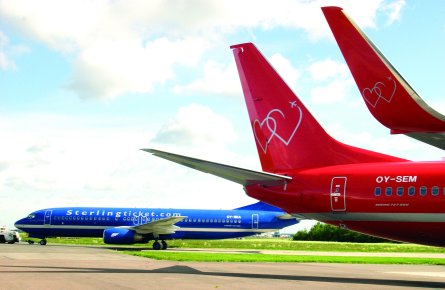The sale of Copenhagen-based budget carrier Sterling to Iceland’s FL Group is set to change the face of the Scandinavian low-cost sector.
The sale comes just as Sterling is integrating its own recent acquisition, fellow Danish carrier Maersk Air. No wonder Sterling’s commercial director Stefan Vilner jokes “a month is a long time in Sterling”.

European low-cost carriers have been taking the first tentative steps in what many see as an inevitable period of consolidation. Sterling chairman Mårten Lunde says: “We have in recent years succeeded in establishing Sterling as the leading low-fare airline in Scandinavia. To further enhance this position, it now appears natural to see a change in the ownership. Within the airline industry we realise that the requirement for critical mass is ever increasing.”
The sale to FL poses intriguing possibilities involving two other carriers. FL has been gradually increasing its stake in UK low-cost giant easyJet, with its share standing at 16% as of mid-November. “It is an indication of interest,” admits Vilner, who argues that with little overlap between the two carriers, which only compete on routes between Copenhagen and London Stansted and Berlin Schoenfeld, a tie-up could be complementary. “There are interesting synergies and little in the way of duplication,” he says.
FL, meanwhile, is also the parent of Icelandair, which has forced Sterling to put on hold its plan to launch long-haul services to North America. The latter is a key market for Icelandair, with its Reykjavik base conveniently situated for traffic from Europe.
Vilner sees the possibility of Sterling feeding traffic into Reykjavik for onward travel to North America with Icelandair. Transfer traffic has traditionally been an anathema for low-cost carriers, but Vilner says that it can be done cheaply, with passengers offered missed connection insurance. “The bottom line is, it is really simple,” he says.
In the short term, Vilner expects business as usual, with perhaps a slight shift in favour of the Mediterranean market. One possibility is Sterling’s charter sector – which currently consists of six dedicated aircraft – being turned into a standalone unit, rather than integrated with the low-cost operations as it is today.
Vilner believes that FL may have to sell Sterling’s sister budget airline Icelandic Express to satisfy competition authorities. “Icelandic Express has been a very lucrative airline for its four owners,” he notes.
Meanwhile, Sterling is to open a base at Helsinki Vantaa airport in March, basing two aircraft in the Finnish capital, serving 11 destinations. “Finland has very little low-cost competition,” Vilner says. “It is like Scandinavia five years ago or the UK in the mid-1990s.” Sterling is also considering setting up a base in Spain.
The carrier expects to carry 5.2 million passengers in 2006, 7 million in 2007 and 9 million in 2008. Sterling, which has a 30-strong fleet at the moment, is looking to add 20 aircraft to cater for growth.
Boeing 737-500s inherited from Maersk Air are to be phased out, enabling Sterling to focus on the 737-700 for short-haul operations and the 737-800 for longer flights.
COLIN BAKER/LONDON
Source: Airline Business























